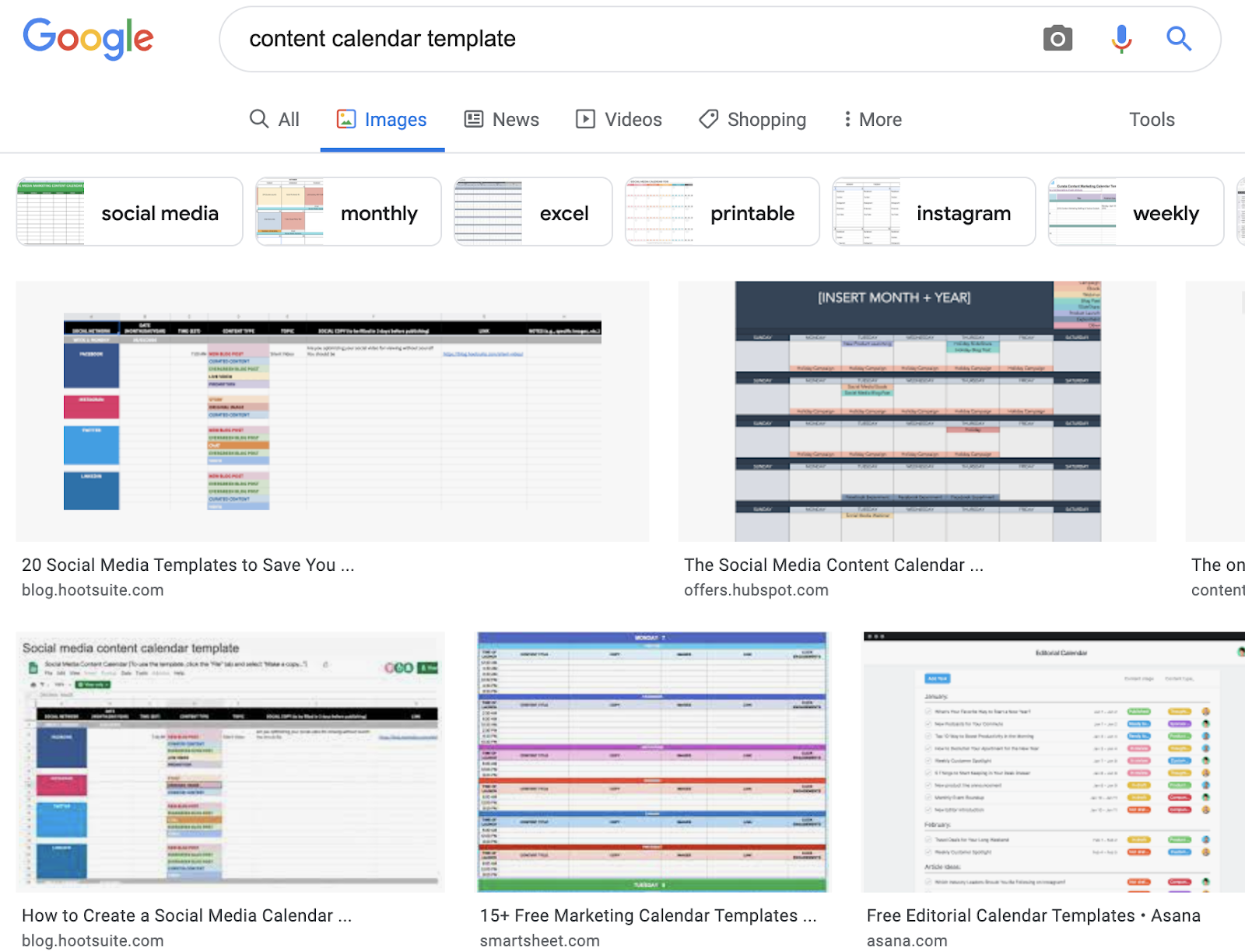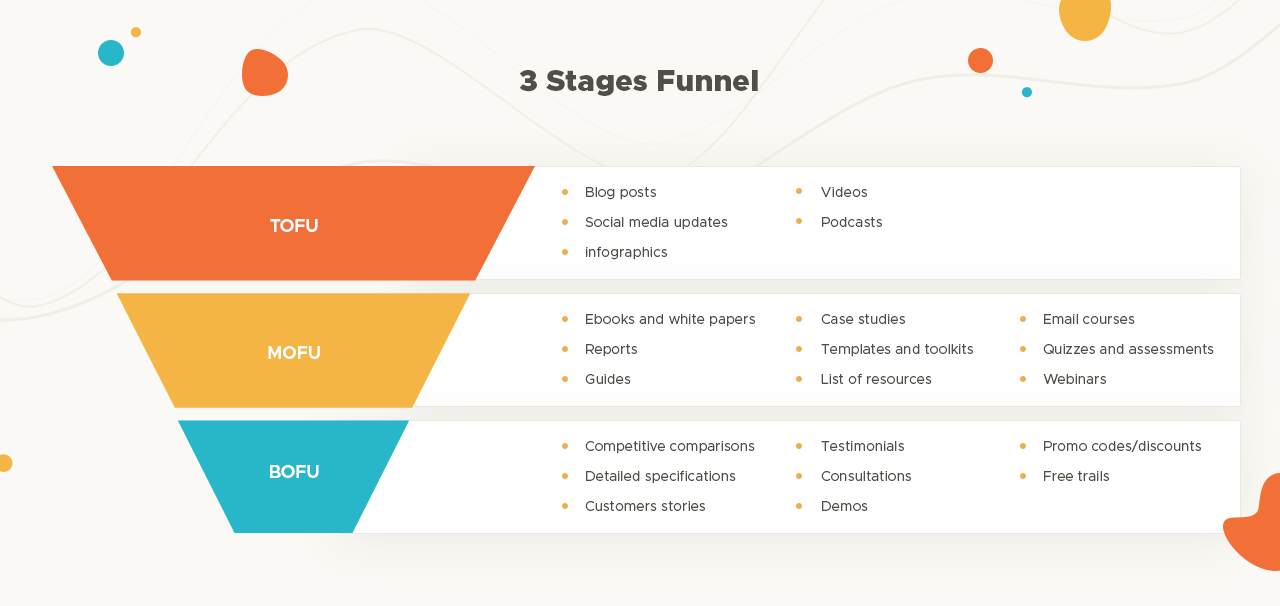When it comes to marketing, there’s a lot of content you can create. And as a marketer, you have tons of ideas. While there’s an ambition to get it all done, a robust content strategy can overwhelm even the most experienced marketers.
We’ve got some encouraging words to say: you can do it! But it’s essential to be organized and plan ahead. In other words, you need a content calendar.
A content calendar is a visual workflow of your content strategy. It helps you keep track of content types, promotional channels, authors, status, and publish dates.
You’re probably thinking: that sounds like a whole lot of work—is it necessary?
Here are three quick reasons why having a content calendar is a must-have for your marketing strategy:
- It keeps you on schedule: Let me guess, content marketing is one of many hats that you wear. Writing down your projects in a content calendar holds you accountable to execute on time and stick to a consistent posting schedule.
- It allows for easy collaboration: A content calendar will act as a source of truth if you’re working with others, internally or externally. This streamlines communication and collaboration. Instead of knocking on your door for answers (and vice versa), they can consult the calendar.
- It provides the big picture: The perfect content calendar plans for months ahead. Why? Knowing what’s in the pipeline allows you to line up content launches with the overall business strategy.
Some say, for every minute spent organizing, an hour is earned. So as part of our Digital Marketing Series, we’re asking you to take less than ten minutes of your day to learn how to create a well-planned, organized content calendar. (Just think about all the hours earned!)
Six Steps for Creating A Content Calendar
If you look up “content calendar template” in Google Images, you’ll find many variations.
Our two cents? Don’t get attached to one template. Use them as guides but find a structure that works best for you.

To help you do that, we’re walking through the five W’s (and one H): Who, What, When, Where, Why, and How. If your content calendar can answer these six questions, consider yourself ready to rock your content strategy.
First, start with why
Behind every good piece of content, there’s a reason why it was created.
To determine the “why,” take a step back and write down your business and marketing objectives. They could be:
-
Driving more website traffic
-
Improving search engine optimization
-
Increasing brand awareness and reach
-
Building customer loyalty
-
Generating more leads
-
Gaining more customers and sales
Once you’ve determined your goals, you can build a campaign strategy and start brainstorming content ideas. It’s helpful to revisit the marketing funnel (and what sorts of content perform best at each stage of the funnel).

Source: Single Grain
For example, if you’re a freshly-launched business that sells eco-friendly cleaning products, you’ll need to build brand awareness and reach. That means your content strategy should focus on creating top-of-funnel (or TOFU) content—like listicles on why you should switch to green products.
Tip: Set aside some KPIs for each piece of content. This’ll keep you focused on the “why.” Standard content marketing metrics are unique page visits (UPVs), downloads, shares, time on page, and inbound links. At the end of the day, pick ones that make sense for your campaign objective!
Then, brainstorm what to create
With marketing objectives as your North Star, it’s time to brainstorm some killer content ideas.
Let’s say you want to launch three to four blog posts each month over the next three months. Sure, it may align with your company’s quarterly strategy to build brand awareness, but how do you pick the topics?
If you’re drawing a blank, try using a content marketing tool, like Social Animal and BuzzSumo. Check out this quick video on BuzzSumo to get acquainted!
What do they do? They analyze top-performing content in your niche and help answer these questions:
-
What types of content generate the most shares?
-
What are the most effective headlines?
-
What content formats work best for your target audience? (For example, short or long-form content.)
-
Which topics are most popular?
This information can help you identify trending topics, keywords to target, the structure of the blog post, and possible titles.
Tip: Don’t forget to take a look at your own analytics. What links are people clicking on? Which emails are they opening? Believe it or not, the answers are right under your nose.
If you don’t have much historical data to work with, we encourage you to pursue feedback. Ask your audience what types of content they want to see! Customers appreciate it when businesses take the time to listen. (It’s super important for reducing customer churn.)
Thirdly, determine how you’ll do it
\ You figured out an amazingly click-worthy title for your next blog post: 101 Ways to Clean Your Dog Using Our Eco-Friendly Cleaning Cloths.
It’s click-worthy for sure and will bring attention to your brand, but can you come up with this content and meet the readers’ expectations? Is it a tangible project? (Can you actually clean a dog 101 ways using your eco-friendly cloth?! We need proof!)
Once you identify the content you want to create, you’ll need to determine how you’ll execute each piece of content.
Put yourself in your future self’s shoes: you’re getting ready to upload your piece of content. Do you have everything you need? Consider this checklist:
-
Is the title confirmed?
-
Is the copy created?
-
Which keywords are targeted?
-
Are the visuals created?
-
Do you have a URL made?
-
When is the publication date and time?
-
Where will it be promoted?
-
When will it be promoted?
-
Are UTM (urchin tracking module) codes created?
-
Which campaign objective does it fall under?
-
Which KPIs will be tracked?
It’s best to get all your ducks in a row to reduce stress at the time of launch. If you’re coming across huge roadblocks to complete a piece of content, then you may want to reconsider it.
You should start creating your content calendar at this stage—it’ll help you visualize all the logistics. In the example below, you can see the information Hubspot chose to include, but feel free to personalize yours and add as many details as you want!
Source: Hubspot
Tip: Here at Galactic Fed, we use Google Sheets for our content calendar. Its cloud-based architecture enables you to collaborate with anyone, anytime, anywhere, on any device. Plus, it’s free. (#NotAnAd, we swear.)
Start creating columns based on the “how.” Remember to ask yourself, what information do you need to include to ensure each piece of content is created? Whatever comes to mind deserves a column. We’ll be tackling some of these now in greater detail.
Afterward, consider where it’ll go
Where your content ends up totally depends on the type of content it is. Let’s say it’s a blog post, infographic, or ebook. Then you’ll probably publish it on your website. If it’s an educational video or webinar recording, you’ll upload it on Youtube or a video hosting platform. Or, if you created some fun video or photo content, you’d likely post it to your social media accounts. In short, where your content lives isn’t so cut and dry.
Neither is where you promote it. After putting in the effort to create a stellar piece of content, you should also put some time into your promotional strategy—actually, a lot of time. Some even recommend the 80/20 split (80% promoting content, 20% creating content). Hey—if you plan it well, you could find opportunities to promote your content months later!
Source: Orbit Media
Here are some places to promote your content:
- Your email list: Those who have opted to hear from you are primed and ready to open, click, and engage with what you send. So start building your email list now if you haven’t already!
- Paid media: Paid media is a great way to attract attention to your content, but it’ll also require additional ad content creation. Many businesses look to outsource their paid media efforts to streamline their content strategy.
- Organic social media: Social media is the perfect place to promote your content—it’s fast and easy. To ensure your posts aren’t missed, we recommend sharing a few times on your social feeds.
- Syndication: If you’ve created a killer blog post, ask other relevant blogs to share it—it’s a great way to reach a new, but similar, audience.
- Influencers: Got some shareable content? Consider promoting it through an influencer in your industry. With so many micro-influencers out there, influencer marketing has become super affordable.
- Content communities: Join content communities such as Inbound.org, Growth Hackers, and Hacker News. We don’t recommend spamming them with posts, but they’re great platforms to share your best content.
As you can see, the options are endless. So for each piece of content you create, you’ll need to carefully consider where you’ll post it and where you’ll promote it. (Yes, this deserves a column in your content calendar!)
Tip: Where you post and promote your content is the tip of the iceberg. To get the most mileage out of your content, make sure it’s easy to share. Clean and simple URLs, “Click to Tweets,” and social share buttons are all ways to encourage more promotion.
Next, figure out who’s responsible
This question may be easy. Perhaps you’re the one creating all the content as well as posting and promoting it.
Or, it may be a team effort. You may be working with several internal teammates and external contractors to get the job done.
If that’s the case, it’s important to establish ownership. To cover all your bases, return back to the “how”:
-
Who is creating the copy?
-
Who is creating the design assets?
-
Who is publishing the content?
-
Who is promoting the content?
Attaching names to each of these responsibilities is essential for coordinating all the moving pieces in a timely manner.
Tip: In your content calendar, beside each team member’s name, include a column that describes the status of their work. Knowing if it’s in the planning stage, drafted and reviewed, or ready for publication will be helpful for all members of your team.
Lastly, nail down when it goes live
The perfect content calendar doesn’t exi—encompasses months of content. As we mentioned, planning well ahead allows you to line up content with business goals. It also ensures you don’t post a bunch of similar content in a row.
With that said, we don’t expect you to have exact dates nailed down months ahead. When you’re planning, try to plop in a general date into the calendar. As each piece comes together, you can adjust it.
To get the most bang for your buck, be strategic about your scheduling. Take a look at your analytics to see when your content receives the most engagement, and try to choose publication dates and times accordingly.
Once you pick a time, we encourage trying to stick to it. If one team member doesn’t, it could delay your entire posting schedule.
Tip: If you’re publishing a lot of content, don’t hesitate to create multiple sheets for each type of content. This will help you stay organized. Or, to help you visualize your posting schedule (and related tasks), consider using a monthly calendar (as the example demonstrates below).

Source: Buffer
It’s Time to Fill Your Calendar With Content
And just like that, you’ve got all the information you need to craft the perfect content calendar—one that is strategic, well-planned, and organized. (Talk about a triple threat!)
If you need help along the way—with SEO or paid media guidance in particular—we’re here to help you. Together, we could fill that calendar with some incredible content!

